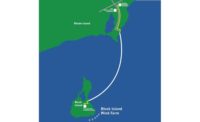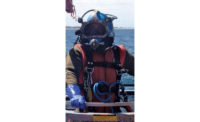
While Cape Wind’s 468-MW offshore wind-farm development appears to be dead in the water, Deepwater Wind is moving full steam into early-stage construction of a $225-million wind farm, three miles southeast of Block Island in Rhode Island.
“The response from the financial markets to the project has been extremely positive,” says Jeffrey Grybowski, chief executive officer of Deepwater Wind, Provincetown, R.I. “We have found a very robust market for our project among lenders and tax-equity providers and expect to complete project financing in the coming months.”
Plans are in place to erect the turbines in late summer 2016 and launch commercial operations in the fourth quarter of 2016, according to a Deepwater Wind spokeswoman. If completed on schedule, the five-turbine, 30-MW offshore wind farm will be the first to put steel in water in the U.S. The turbines will stand 600 ft high and are designed to withstand a Category 3 storm.
Steel-jacket foundation fabrication began this month at Gulf Island Fabrication, Houma, La. “Installation of the five jackets will take place this summer over approximately eight weeks, using a spread of vessels, including a barge-based crane,” Grybowski says. Keystone Engineering, Mandeville, La., finished jacket design at the end of 2014.
After analyzing several types of foundations, including monopoles and gravity-base foundations, Deepwater Wind settled on jacket foundations as the most cost-effective for the water depth of 90 ft to 100 ft and in light of the meteorological and oceanographic data, he says.
“There is a long and successful track record of offshore deployment of jacket foundations in the oil-and-gas industry in water depths much deeper than the Block Island project,” Grybowski says. “Jackets allow us to conduct above-water pile driving, which has far less impact to sensitive marine species, especially whales.”
The Deepwater Wind spokeswoman says the project could produce energy at costs lower than projected when state regulators approved a 20-year power-purchase agreement between Deepwater Wind and National Grid in 2010.
“In 2009, we expected a [wind turbine] net-capacity factor of approximately 40%, but our current estimate, based on specifications of the Alstom Haliade 6-MW [turbine] and our wind-resource assessment is in the mid- to high 40s,” she says. The net-capacity factor indicates how much electricity a wind turbine actually produces compared to how much it would produce if it operated all the time.






